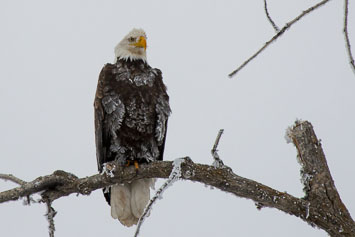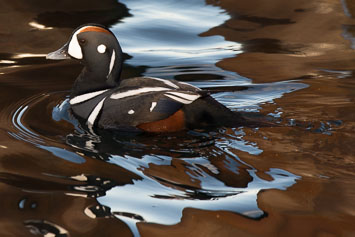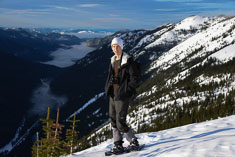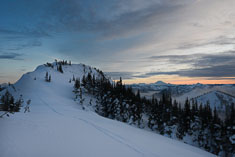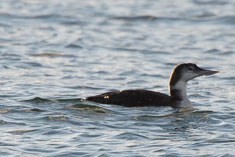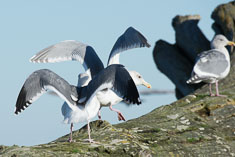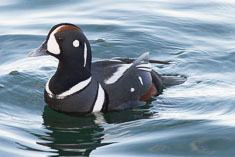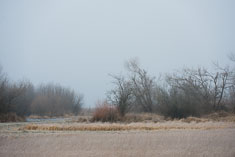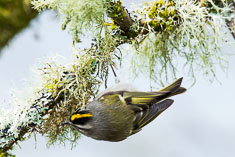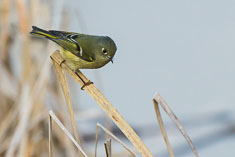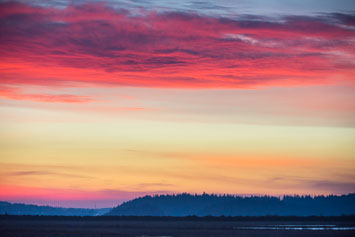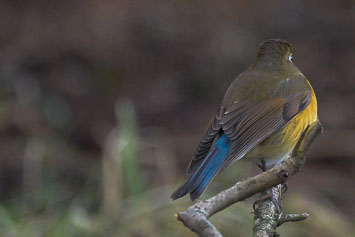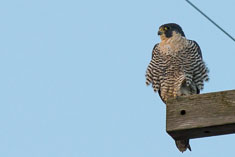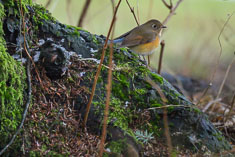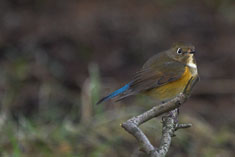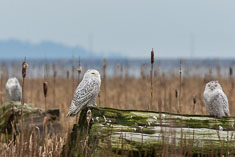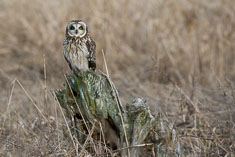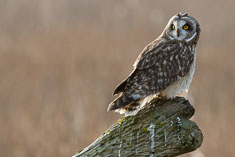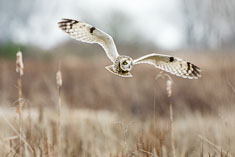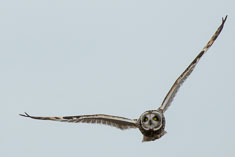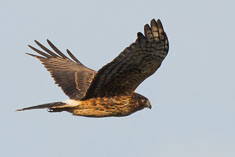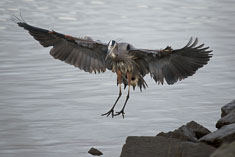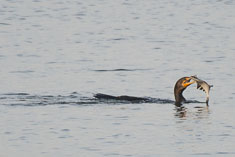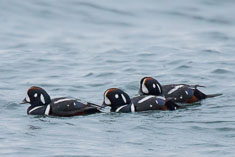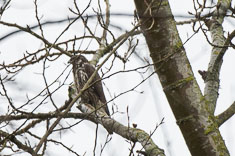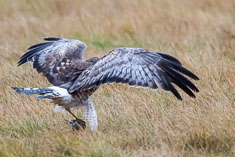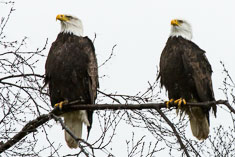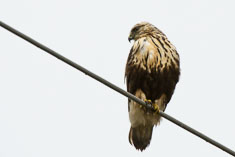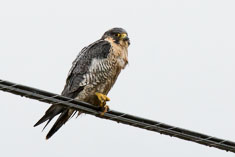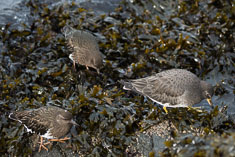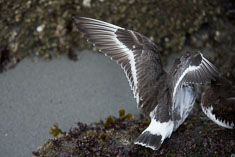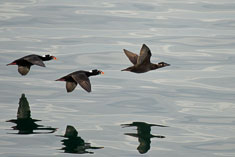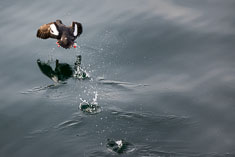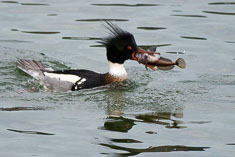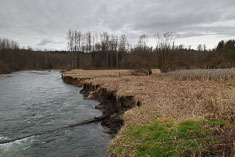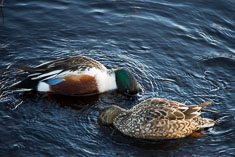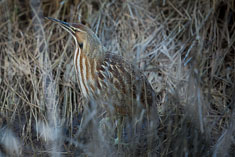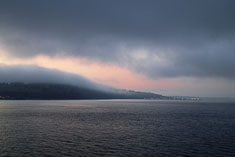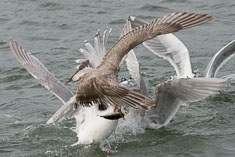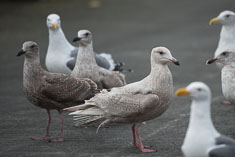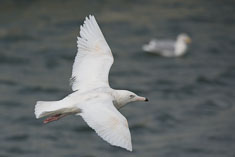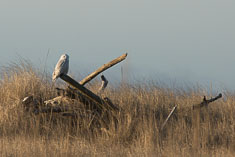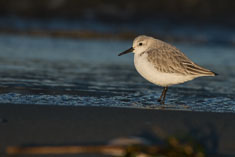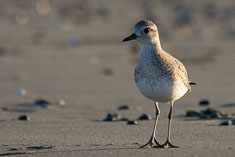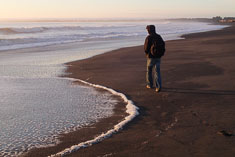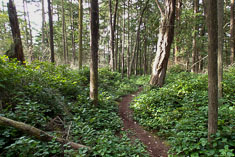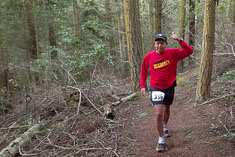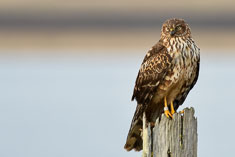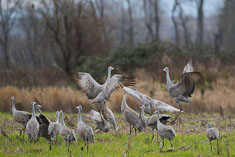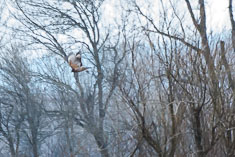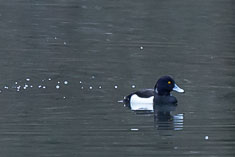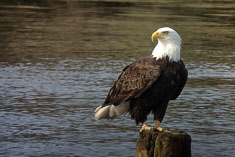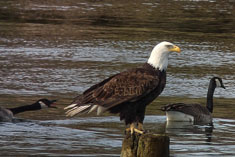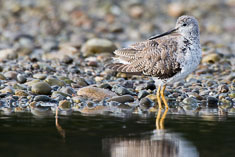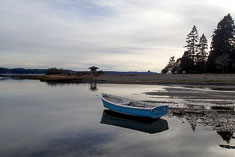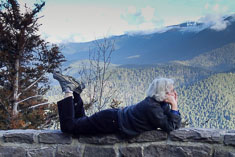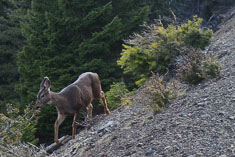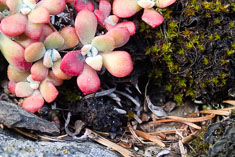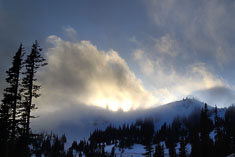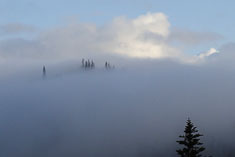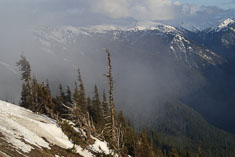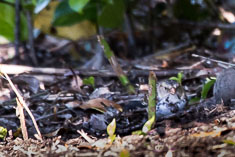1/1/2013
Between birding this morning around the house and a late afternoon five mile run, I spotted 32 species to kick off the year today, including a Northern Flicker in the back yard with three yellow primaries on his red-shafted wings. We had a mostly yellow-shafted flicker around here last summer but haven't seen it for several months, perhaps because we only started filling the feeders in the last few days. The usual suspects have returned but so far, no White-throated Sparrows.
Between birding this morning around the house and a late afternoon five mile run, I spotted 32 species to kick off the year today, including a Northern Flicker in the back yard with three yellow primaries on his red-shafted wings. We had a mostly yellow-shafted flicker around here last summer but haven't seen it for several months, perhaps because we only started filling the feeders in the last few days. The usual suspects have returned but so far, no White-throated Sparrows.
1/6/2013 Crystal Mountain
David and I snowshoed up to Cement Ridge, up by the Crystal Mountain Ski Area, today. We took more or less the same route as last time and left about the same time too, despite our intention to get an early start. Fog was pouring over the ridges to the south of us as we set out but had cleared by the time we reached the old burn. We enjoyed a bright and sunny hike up to the ridge after lunch on a crag overlooking the ski area. Up on top once again we had time for only a little exploring before sunset. We hurried down and reached the car at dusk.
David and I snowshoed up to Cement Ridge, up by the Crystal Mountain Ski Area, today. We took more or less the same route as last time and left about the same time too, despite our intention to get an early start. Fog was pouring over the ridges to the south of us as we set out but had cleared by the time we reached the old burn. We enjoyed a bright and sunny hike up to the ridge after lunch on a crag overlooking the ski area. Up on top once again we had time for only a little exploring before sunset. We hurried down and reached the car at dusk.
1/11/2013 Port Angeles birding
Often when a rare bird is reported I put off going to look for it for so long that I never do get out to see it. I decided that this time would be different. A rather rare Thick-billed Murre has been reported in Port Angeles harbor for about a week now and today, despite too little sleep and the 200-mile round trip in the car and not knowing anything about the area, I went looking for it. I'd forgottent how much fun it is to go birding somewhere new. I reached Port Angeles by 8:30 and found my way west of town through the paper mill to Ediz Hook, the breakwater/sand spit enclosing the harbor. For the first hour or so I was distracted by a Common Loon which I thought might be a Yellow-billed (I'm not very familiar with loons). I took lots of photos but began to suspect it might be a Common when I saw two other loons with the same pattern of dark and light on the neck. While chasing the loon I photographed a small group of Barrow's Goldeneyes but the morning stratus deck had cleared and the light was too harsh for good results.
Continuing out towards the Coast Guard station at the end of the road, I spotted some other birders scanning the harbor with scopes so I stopped and got my scope out too. Pretty soon we had a likely Thick-billed candidate, though so distant that even with the scope it was difficult to make out the field marks. A slight wind chop on the water meant that we never saw more then a glimpse of the bird but eventually I got enough glimpses to confirm the dark neck and clean line between light and dark which extends back from the bill below the eye then curves forward again onto the front of the neck and upper breast. The Common Murres accompanying it all either had white above/behind the eye (winter plumage) or a dark throat and face (summer plumage). Another birder had a Nikon 600 f4 with a 1.4 teleconverter but had forgotten his tripod so I let him borrow mine. Even with that reach I couldn't pick out the field marks from his photos.
I got up my courage to inquire at the coast guard station if access was allowed beyond the gate. It wasn't. I ate lunch and photographed some of the gulls that gathered around for leftovers, then drove back around to the mainland side of the harbor where some shorebirds, including a Rock Sandpiper, had been reported. Boat Haven was the name of the access point, I think. I found the sandpiper with a flock of Dunlin and a few Black-bellied Plovers. A couple other cars stopped by, disgorging birders including Kurt and Bobby whom I'd met earlier, friends of Ed Newbold I later found out. I was more excited by a close-in Harlequin duck than by the shorebirds, though I did stop on the way out of town to try, successfully, for a closer view of the Ruddy Turnstones we'd seen through the scope on some distant riprap.
Often when a rare bird is reported I put off going to look for it for so long that I never do get out to see it. I decided that this time would be different. A rather rare Thick-billed Murre has been reported in Port Angeles harbor for about a week now and today, despite too little sleep and the 200-mile round trip in the car and not knowing anything about the area, I went looking for it. I'd forgottent how much fun it is to go birding somewhere new. I reached Port Angeles by 8:30 and found my way west of town through the paper mill to Ediz Hook, the breakwater/sand spit enclosing the harbor. For the first hour or so I was distracted by a Common Loon which I thought might be a Yellow-billed (I'm not very familiar with loons). I took lots of photos but began to suspect it might be a Common when I saw two other loons with the same pattern of dark and light on the neck. While chasing the loon I photographed a small group of Barrow's Goldeneyes but the morning stratus deck had cleared and the light was too harsh for good results.
Continuing out towards the Coast Guard station at the end of the road, I spotted some other birders scanning the harbor with scopes so I stopped and got my scope out too. Pretty soon we had a likely Thick-billed candidate, though so distant that even with the scope it was difficult to make out the field marks. A slight wind chop on the water meant that we never saw more then a glimpse of the bird but eventually I got enough glimpses to confirm the dark neck and clean line between light and dark which extends back from the bill below the eye then curves forward again onto the front of the neck and upper breast. The Common Murres accompanying it all either had white above/behind the eye (winter plumage) or a dark throat and face (summer plumage). Another birder had a Nikon 600 f4 with a 1.4 teleconverter but had forgotten his tripod so I let him borrow mine. Even with that reach I couldn't pick out the field marks from his photos.
I got up my courage to inquire at the coast guard station if access was allowed beyond the gate. It wasn't. I ate lunch and photographed some of the gulls that gathered around for leftovers, then drove back around to the mainland side of the harbor where some shorebirds, including a Rock Sandpiper, had been reported. Boat Haven was the name of the access point, I think. I found the sandpiper with a flock of Dunlin and a few Black-bellied Plovers. A couple other cars stopped by, disgorging birders including Kurt and Bobby whom I'd met earlier, friends of Ed Newbold I later found out. I was more excited by a close-in Harlequin duck than by the shorebirds, though I did stop on the way out of town to try, successfully, for a closer view of the Ruddy Turnstones we'd seen through the scope on some distant riprap.
1/16/2013 Nisqually NWR Bird list
I made it out to join the Wednesday morning bird walk at Nisqually NWR this morning. Conditions were foggy and frosty; most freshwater was frozen over and the fog limited visibility somewhat, but we still managed to find 52 species.
Quite a crowd shows up for these outings; at least 20 people had gathered on the porch at the Visitor Center by 8:15. I started out using just binoculars, keeping the scope and camera in my pack and tripod strapped on back, but the tripod legs kept bumping into my calves and I found I needed the scope out anyway so I stopped to unpack it. Unfortunately carrying the scope meant that I had to put it down in order to use my binoculars. Then when we encountered a Merlin up in a fog-shrouded cottonwood, I dug out the camera and added it to the tangle of gear around my neck. I never did find a really satisfactory way to have everything out and available.
While with the group I didn't do very well with photos either, but the group turned back around 11AM at the start of the boardwalk. I continued with a woman named Laurel, who was both a photographer and a competent birder, so we were pretty compatible. We stopped to get pictures of a young and rather tame Bald Eagle, then found a flock of Least Sandpipers and a Greater Yellowlegs as the dropping tide began to expose some mudflats along the boardwalk. I photographed a gull chasing a Mallard but couldn't tell why until I enlarged the image and saw the little crab the Mallard had clamped in the tip of its bill. Returning to headquarters we had a close encounter with a flock of Golden-crowned Kinglets, almost too close for photos, and back at the VC a brightly-colored Ruby-crowned Kinglet was flycatching from the cattails below the porch.
The last new bird of the day, a Northern Shrike at the Nisqually River overlook, upped my 2013 Washington total to 105.
I made it out to join the Wednesday morning bird walk at Nisqually NWR this morning. Conditions were foggy and frosty; most freshwater was frozen over and the fog limited visibility somewhat, but we still managed to find 52 species.
Quite a crowd shows up for these outings; at least 20 people had gathered on the porch at the Visitor Center by 8:15. I started out using just binoculars, keeping the scope and camera in my pack and tripod strapped on back, but the tripod legs kept bumping into my calves and I found I needed the scope out anyway so I stopped to unpack it. Unfortunately carrying the scope meant that I had to put it down in order to use my binoculars. Then when we encountered a Merlin up in a fog-shrouded cottonwood, I dug out the camera and added it to the tangle of gear around my neck. I never did find a really satisfactory way to have everything out and available.
While with the group I didn't do very well with photos either, but the group turned back around 11AM at the start of the boardwalk. I continued with a woman named Laurel, who was both a photographer and a competent birder, so we were pretty compatible. We stopped to get pictures of a young and rather tame Bald Eagle, then found a flock of Least Sandpipers and a Greater Yellowlegs as the dropping tide began to expose some mudflats along the boardwalk. I photographed a gull chasing a Mallard but couldn't tell why until I enlarged the image and saw the little crab the Mallard had clamped in the tip of its bill. Returning to headquarters we had a close encounter with a flock of Golden-crowned Kinglets, almost too close for photos, and back at the VC a brightly-colored Ruby-crowned Kinglet was flycatching from the cattails below the porch.
The last new bird of the day, a Northern Shrike at the Nisqually River overlook, upped my 2013 Washington total to 105.
1/18/2013 Red-flanked Bluetail
Now I'm really chasing birds. A Red-flanked Bluetail, an Asian relative of the European Robin, has been reported from Queen's Park in New Westminster BC. It's only the second North American record outside of western Alaska, and only about a half hour north of the border which in turn is just over two hours from home. Reports indicated it was easiest to find early in the morning so figuring I'd get more sleep if I drove up the day before, I spent the night in Bellingham. I stayed at the Coachman Inn, a reasonably-priced but very comfortable place with helpful staff and a well-stocked breakfast in the morning. I ate at a highly-rated Mexican place downtown called Tadeo's. The food was good, though not memorably so.
On the way north I stopped at Wylie Slough to look for a Northern Waterthrush which I later learned had probably departed a month earlier. I did find a juvenile Peregrine and a nice photo of hazy alder trunks reflected in the slough. Continuing north to Samish Flats via Best Road I passed a flock of about 600 swans and managed to pick out both Trumpeter and Tundra Swams with the scope. Most seemed somewhere in between the descriptions of the two species, except that only a few had visible yellow lores. Those were definitely Tundras. I figured most of the others were Tundras as well, and I just couldn't see the yellow lores. A few clearly seemed larger, with a larger bill, and those I figured to be Trumpeters. Later I found out that Trumpeters generally significantly outnumber Tundras in this area, so most of those swans were probably Trumpeters.
The Samish Flats were full of Short-eared Owls and Rough-legged Hawks. I waited until past sunset at the West 90 in hopes that the recently-seen Long-eared Owl would fly by but it did not. I hadn't been to the West 90 in years, at least not for birding. It turns out to be near the turnaround on the Skagit Flats Marathon course and I've used the porta-potties there a couple of times during the race. Too bad the marathon isn't in the winter when all the birds are there.
I arrived at Queen's Park around 8:30AM, delayed somewhat by traffic, and parked on the west side of the park since I couldn't get in from the east side the way Google Maps told me to. That worked out well though because all I had to do was cross the street and I was in Bluetail territory. At first I found only other birders, who reported that the Bluetail had already been seen, was still in the area and would show up soon if we just hung around and waited. They were right. It showed up after about 15 minutes.
In both behavior and appearance it seems unlike any local bird. Its preferred area of the park is forested, mature cedars and Doug firs spaced maybe 50 feet apart with just duff underneat and a few straggly shrubs and small logs scattered about. The bird forages by flying down to the ground from low perchs in the shrubs or on logs or tree trunks. It moves 100 feet or so to a new location every few minutes, and occasionally flies up 10-20' into a tree from which it then makes a longer (and usually undetected) flight to another area, possibly in response to birder pressure though I thought that nearly all of the birders and photographers present were giving the bird enough space. It appeared to be eating invisible insects on or near the ground, along with some seed scattered on logs by helpful birders.
A couple of birders I met at the West 90 had suggested Brunswick Point at the end of River Road past Reifel Refuge as a good spot to see Snowy and Short-eared Owls, so I'd planned to head over there from Queen's Park after I saw the Bluetail. Getting decent photos of the Bluetail took a while; I eventually managed to be in the right place at the right time. It perched near me in fairly good light and I got my photos without disturbing it, as far as I could tell. Waiting around during one of the times the bird disappeared, I got to talking with a young man named Zack who was carrying a D90. I showed him a couple things on his camera to help him get better photos, then invited him and his mom Cara to come to Brunswick Point. We caravaned over there. Arriving around 1:30PM, we had the place pretty much to ourselves. We followed a dike out from the end of the road, with first the river, then a tidal overflow marsh on one side and agricultural fields on the other. About a half mile out we found owls - a Short-eared strafing a Rough-leg up in a cottonwood and a half-dozen Snowies on logs out in the marsh.
Zack and I ventured out into the marsh while Cara waited patiently on a conveniently-located bench on the dike. I should have worn boots, because I soon soaked my new running shoes with richly rust-colored water. I also flushed the first Snowy I approached. Oops. I didn't flush any others while still managing to get some passable pictures. Done with the Snowies, Zack and I converged on the trail back to the dike and a Short-eared Owl landed nearby. It seemed undisturbed by our presence so we ever so slowly crept closer, and closer, until we were just twenty feet away. I was too close for the teleconverter and took it off. The owl stayed put on in perch in the cattails, even spitting up a pellet while we watched. We retreated and finally it took off, flying around us, diving into the cattails once or twice, perching nearby again, while we took hundreds of photos. Finally we returned to the dike where Cara was waiting and started back to the cars. Once again the Short-eared Owl flew by and perched on a big piece of driftwood right near the dike. We took more photos. The sun emerged below the edge of the stratus deck overhead. We took more photos. We got some photos of Northern Harriers, common over the marsh, as well. What a great day!
Now I'm really chasing birds. A Red-flanked Bluetail, an Asian relative of the European Robin, has been reported from Queen's Park in New Westminster BC. It's only the second North American record outside of western Alaska, and only about a half hour north of the border which in turn is just over two hours from home. Reports indicated it was easiest to find early in the morning so figuring I'd get more sleep if I drove up the day before, I spent the night in Bellingham. I stayed at the Coachman Inn, a reasonably-priced but very comfortable place with helpful staff and a well-stocked breakfast in the morning. I ate at a highly-rated Mexican place downtown called Tadeo's. The food was good, though not memorably so.
On the way north I stopped at Wylie Slough to look for a Northern Waterthrush which I later learned had probably departed a month earlier. I did find a juvenile Peregrine and a nice photo of hazy alder trunks reflected in the slough. Continuing north to Samish Flats via Best Road I passed a flock of about 600 swans and managed to pick out both Trumpeter and Tundra Swams with the scope. Most seemed somewhere in between the descriptions of the two species, except that only a few had visible yellow lores. Those were definitely Tundras. I figured most of the others were Tundras as well, and I just couldn't see the yellow lores. A few clearly seemed larger, with a larger bill, and those I figured to be Trumpeters. Later I found out that Trumpeters generally significantly outnumber Tundras in this area, so most of those swans were probably Trumpeters.
The Samish Flats were full of Short-eared Owls and Rough-legged Hawks. I waited until past sunset at the West 90 in hopes that the recently-seen Long-eared Owl would fly by but it did not. I hadn't been to the West 90 in years, at least not for birding. It turns out to be near the turnaround on the Skagit Flats Marathon course and I've used the porta-potties there a couple of times during the race. Too bad the marathon isn't in the winter when all the birds are there.
I arrived at Queen's Park around 8:30AM, delayed somewhat by traffic, and parked on the west side of the park since I couldn't get in from the east side the way Google Maps told me to. That worked out well though because all I had to do was cross the street and I was in Bluetail territory. At first I found only other birders, who reported that the Bluetail had already been seen, was still in the area and would show up soon if we just hung around and waited. They were right. It showed up after about 15 minutes.
In both behavior and appearance it seems unlike any local bird. Its preferred area of the park is forested, mature cedars and Doug firs spaced maybe 50 feet apart with just duff underneat and a few straggly shrubs and small logs scattered about. The bird forages by flying down to the ground from low perchs in the shrubs or on logs or tree trunks. It moves 100 feet or so to a new location every few minutes, and occasionally flies up 10-20' into a tree from which it then makes a longer (and usually undetected) flight to another area, possibly in response to birder pressure though I thought that nearly all of the birders and photographers present were giving the bird enough space. It appeared to be eating invisible insects on or near the ground, along with some seed scattered on logs by helpful birders.
A couple of birders I met at the West 90 had suggested Brunswick Point at the end of River Road past Reifel Refuge as a good spot to see Snowy and Short-eared Owls, so I'd planned to head over there from Queen's Park after I saw the Bluetail. Getting decent photos of the Bluetail took a while; I eventually managed to be in the right place at the right time. It perched near me in fairly good light and I got my photos without disturbing it, as far as I could tell. Waiting around during one of the times the bird disappeared, I got to talking with a young man named Zack who was carrying a D90. I showed him a couple things on his camera to help him get better photos, then invited him and his mom Cara to come to Brunswick Point. We caravaned over there. Arriving around 1:30PM, we had the place pretty much to ourselves. We followed a dike out from the end of the road, with first the river, then a tidal overflow marsh on one side and agricultural fields on the other. About a half mile out we found owls - a Short-eared strafing a Rough-leg up in a cottonwood and a half-dozen Snowies on logs out in the marsh.
Zack and I ventured out into the marsh while Cara waited patiently on a conveniently-located bench on the dike. I should have worn boots, because I soon soaked my new running shoes with richly rust-colored water. I also flushed the first Snowy I approached. Oops. I didn't flush any others while still managing to get some passable pictures. Done with the Snowies, Zack and I converged on the trail back to the dike and a Short-eared Owl landed nearby. It seemed undisturbed by our presence so we ever so slowly crept closer, and closer, until we were just twenty feet away. I was too close for the teleconverter and took it off. The owl stayed put on in perch in the cattails, even spitting up a pellet while we watched. We retreated and finally it took off, flying around us, diving into the cattails once or twice, perching nearby again, while we took hundreds of photos. Finally we returned to the dike where Cara was waiting and started back to the cars. Once again the Short-eared Owl flew by and perched on a big piece of driftwood right near the dike. We took more photos. The sun emerged below the edge of the stratus deck overhead. We took more photos. We got some photos of Northern Harriers, common over the marsh, as well. What a great day!
1/19/2013 Eastern Washington birding trip - day 1 Bird list for the day
Wayne and I left the house around 6:30AM and drove to Omak via Davenport. Naturally we ran out of daylight but we did manage to see several of the species we were looking for including White-winged Crossbills and Snow Buntings. Our first birding stop was at Ryegrass Summit east of Ellensberg. We emerged from the fog about a mile west of the rest area and all the grasses and shrubs were coated with a thick layer of rime and frost. Hopping out of the car at the rest area I glanced at the pinkish finches perched on a frost-covered ornamental and shouted "Redpolls". Wayne jumped out with his binoculars and replied "I think maybe they're house finches." We picked up three species there - House Sparrows, the House Finches and Starlings.
The first interesting bird we stopped to look at was a Merlin at I-90 exit 151 two miles NE of George. We photographed it on top of a light pole before continuing up Hwy 283 to Ephrata and Soap Lake. We stopped at Soap Lake, found only some Canada Geese and a few Goldeneyes in the mostly frozen lake before driving east past the south end of the lake and up the hill to some orchards. A Gyrfalcon had been reported in the area some time ago. Wayne thought he might have seen it but we couldn't find it again. We did see a distant dark-phase Harlan's hawk on a water tank, definitely a BVD (Better View Desired).
Continuing east on hwy 28 we photographed a dark-phase Rough-leg east of Wilson then stopped at the site of an old homestead, now marked only by a grove of mature cottonwoods, where 20.5 road intersects hwy 28. Wayne spotted some American Tree Sparrows among the White-crowneds there, and I noticed several elk working their way up over the ridge to the southwest of us. The 12 miles or so from there east to Odessa were particularly good for hawks. We got some good photos of a cooperative Prairie Falcon and counted 8 more Rough-legs and 4 Red-tails. East of Odessa hwy 28 climbs up onto a featureless plateau, mostly dry-land wheat farmland covered with a foot or so of frosted old snow, where we passed flocks of Horned Larks, one of which contained a couple of Snow Buntings. A few miles later we flushed a whole flock of Snow Buntings but unfortunately they flew up over the snow plain and kept on going out of sight.
Approaching Davenport we spotted the grove of tall spruce trees marking the Mountain View cemetery, a little island of dark green in a rolling sea of snow-covered wheat fields. Driving up, we found another birder already tromping around under the spruces. Yes, he'd seen the White-winged Crossbills, though currently he didn't know exactly where they were. We got out and started tromping around in the snow ourselves and pretty soon I heard crossbill calls up in the treetops. They were hard to spot, as usual, but eventually I got a fix on them and they did indeed have bright white wingbars. There were at least three of them along with a half-dozen or so Red Crossbills. The Red Crossbills eventually came down to forage for gravel? in the bare road by the cemetery but the White-wings stayed in the treetops.
Bohemian Waxwings had been reported in Davenport but though we drove half the streets in town, we didn't find them. We did find another Merlin, a flock of California Quail and the usual town birds. Heading northeast out of town we drove down Hawk Creek Canyon road all the way to the campground at the end. The afternoon was waning and I didn't expect to find much when we got out to walk around, but we found a flock of Wild Turkeys, a Townsend's Solitaire and a Northern Shrike along with ducks in the lake and California Quail getting ready to roost in the thickets. The last species of the day was a Great Horned Owl on a utility pole along US 2 east of Creston. We pulled into Omak around 7PM just in time to join the ABC field trip group at the Breadline Cafe.
Wayne and I left the house around 6:30AM and drove to Omak via Davenport. Naturally we ran out of daylight but we did manage to see several of the species we were looking for including White-winged Crossbills and Snow Buntings. Our first birding stop was at Ryegrass Summit east of Ellensberg. We emerged from the fog about a mile west of the rest area and all the grasses and shrubs were coated with a thick layer of rime and frost. Hopping out of the car at the rest area I glanced at the pinkish finches perched on a frost-covered ornamental and shouted "Redpolls". Wayne jumped out with his binoculars and replied "I think maybe they're house finches." We picked up three species there - House Sparrows, the House Finches and Starlings.
The first interesting bird we stopped to look at was a Merlin at I-90 exit 151 two miles NE of George. We photographed it on top of a light pole before continuing up Hwy 283 to Ephrata and Soap Lake. We stopped at Soap Lake, found only some Canada Geese and a few Goldeneyes in the mostly frozen lake before driving east past the south end of the lake and up the hill to some orchards. A Gyrfalcon had been reported in the area some time ago. Wayne thought he might have seen it but we couldn't find it again. We did see a distant dark-phase Harlan's hawk on a water tank, definitely a BVD (Better View Desired).
Continuing east on hwy 28 we photographed a dark-phase Rough-leg east of Wilson then stopped at the site of an old homestead, now marked only by a grove of mature cottonwoods, where 20.5 road intersects hwy 28. Wayne spotted some American Tree Sparrows among the White-crowneds there, and I noticed several elk working their way up over the ridge to the southwest of us. The 12 miles or so from there east to Odessa were particularly good for hawks. We got some good photos of a cooperative Prairie Falcon and counted 8 more Rough-legs and 4 Red-tails. East of Odessa hwy 28 climbs up onto a featureless plateau, mostly dry-land wheat farmland covered with a foot or so of frosted old snow, where we passed flocks of Horned Larks, one of which contained a couple of Snow Buntings. A few miles later we flushed a whole flock of Snow Buntings but unfortunately they flew up over the snow plain and kept on going out of sight.
Approaching Davenport we spotted the grove of tall spruce trees marking the Mountain View cemetery, a little island of dark green in a rolling sea of snow-covered wheat fields. Driving up, we found another birder already tromping around under the spruces. Yes, he'd seen the White-winged Crossbills, though currently he didn't know exactly where they were. We got out and started tromping around in the snow ourselves and pretty soon I heard crossbill calls up in the treetops. They were hard to spot, as usual, but eventually I got a fix on them and they did indeed have bright white wingbars. There were at least three of them along with a half-dozen or so Red Crossbills. The Red Crossbills eventually came down to forage for gravel? in the bare road by the cemetery but the White-wings stayed in the treetops.
Bohemian Waxwings had been reported in Davenport but though we drove half the streets in town, we didn't find them. We did find another Merlin, a flock of California Quail and the usual town birds. Heading northeast out of town we drove down Hawk Creek Canyon road all the way to the campground at the end. The afternoon was waning and I didn't expect to find much when we got out to walk around, but we found a flock of Wild Turkeys, a Townsend's Solitaire and a Northern Shrike along with ducks in the lake and California Quail getting ready to roost in the thickets. The last species of the day was a Great Horned Owl on a utility pole along US 2 east of Creston. We pulled into Omak around 7PM just in time to join the ABC field trip group at the Breadline Cafe.
1/20/2013 Eastern Washington birding trip - day 2 Bird list for the day
Following Ken Brown and the Advanced Birding Club field trip, we left the hotel at dawn - around 7AM - and drove north to Riverside, then up the Riverside Cutoff Road to the Conconully Road. Pulling into Conconully we clambered out of our vehicles into crisp sunlight. Packed snow on the streets squeaked underfoot as we walked around looking for White-winged Crossbills and Bohemian Waxwings. Not finding either one, we split up and drove up a couple of canyons leading out of town. Ken pointed out a Northern Goshawk flying across the road ahead of us; I caught an unsatisfactory glimpse of it. We found a few goldfinches and chickadees up the canyon and lots of California Quail and Mule Deer in town, but no crossbills. We reassembled in the village and were about to head out of town following a potty stop at the park by the lake when we and another car simultaneously spotted crossbills, White-winged, in an alder tree at the edge of the park. After a few minutes they flew up into nearby spruces to work on cones and we all got good views.
A few miles out of town, as we were driving down an open valley blanketed with snow, Wayne spotted a flock of grouse sitting in a bush on the ridge above us. The group stopped for a closer look and identified the grouse as Sharp-tailed, another of our target species. We admired them through someone's scope, then others in the party found a few more closer at hand, in Water Birch along the stream by the road. They're plump birds, pale in the bright light reflecting off the snow, with attractive beige and brown scalloped breast and upperparts, and a short pointed tail.
Continuing on to Brewster we stopped at the junction of hwy 17 and 97 to scan the apple orchards for waxwings. We didn't see any at first. I confidently called a House Finch a Pine Grosbeak but my goof was soon overshadowed by the unusually pale Buteo someone spotted sitting on the blade of one of the big fans growers use for moving the air around on cold nights. Ken identified it as a light-phase Harlan's and got pretty excited about it, telling us we might go several years before we saw another. I managed to get a few photos of it perched and in flight, a very pale Red-tail with lots of white on the head and only a trace of a belly band and wrist markings on the underwing. The tail was pale brown barred with darker brown above and almost white from below. Admiring the Harlan's, we found a big flock of Bohemian Waxwings in nearby Lombardy poplars, then both a Prairie Falcon and a Sharp-shinned Hawk by a barn not too far from the highway.
We drove the Cameron Lakes loop in the afternoon, climbing up out of the fog on an icy road and into a brilliant snowy landscape sparkling in the sunshine under a bright blue sky. As around Odessa yesterday, all exposed vegetation bristled with frost and everything was white. Ken stopped the group several times simply for scenery photos - uncharacteristic of him according to others in the group. We didn't find many birds to stop for, no Gyrfalcons or Snow Buntings, and not even many chickadees, though we did manage to call up a White-headed Woodpecker in a patch of Ponderosa Pine. It flew too quickly over us for good views. That was about our last stop before we descended back into the fog at sunset and returned to Omak for dinner at a Mexican place.
Following Ken Brown and the Advanced Birding Club field trip, we left the hotel at dawn - around 7AM - and drove north to Riverside, then up the Riverside Cutoff Road to the Conconully Road. Pulling into Conconully we clambered out of our vehicles into crisp sunlight. Packed snow on the streets squeaked underfoot as we walked around looking for White-winged Crossbills and Bohemian Waxwings. Not finding either one, we split up and drove up a couple of canyons leading out of town. Ken pointed out a Northern Goshawk flying across the road ahead of us; I caught an unsatisfactory glimpse of it. We found a few goldfinches and chickadees up the canyon and lots of California Quail and Mule Deer in town, but no crossbills. We reassembled in the village and were about to head out of town following a potty stop at the park by the lake when we and another car simultaneously spotted crossbills, White-winged, in an alder tree at the edge of the park. After a few minutes they flew up into nearby spruces to work on cones and we all got good views.
A few miles out of town, as we were driving down an open valley blanketed with snow, Wayne spotted a flock of grouse sitting in a bush on the ridge above us. The group stopped for a closer look and identified the grouse as Sharp-tailed, another of our target species. We admired them through someone's scope, then others in the party found a few more closer at hand, in Water Birch along the stream by the road. They're plump birds, pale in the bright light reflecting off the snow, with attractive beige and brown scalloped breast and upperparts, and a short pointed tail.
Continuing on to Brewster we stopped at the junction of hwy 17 and 97 to scan the apple orchards for waxwings. We didn't see any at first. I confidently called a House Finch a Pine Grosbeak but my goof was soon overshadowed by the unusually pale Buteo someone spotted sitting on the blade of one of the big fans growers use for moving the air around on cold nights. Ken identified it as a light-phase Harlan's and got pretty excited about it, telling us we might go several years before we saw another. I managed to get a few photos of it perched and in flight, a very pale Red-tail with lots of white on the head and only a trace of a belly band and wrist markings on the underwing. The tail was pale brown barred with darker brown above and almost white from below. Admiring the Harlan's, we found a big flock of Bohemian Waxwings in nearby Lombardy poplars, then both a Prairie Falcon and a Sharp-shinned Hawk by a barn not too far from the highway.
We drove the Cameron Lakes loop in the afternoon, climbing up out of the fog on an icy road and into a brilliant snowy landscape sparkling in the sunshine under a bright blue sky. As around Odessa yesterday, all exposed vegetation bristled with frost and everything was white. Ken stopped the group several times simply for scenery photos - uncharacteristic of him according to others in the group. We didn't find many birds to stop for, no Gyrfalcons or Snow Buntings, and not even many chickadees, though we did manage to call up a White-headed Woodpecker in a patch of Ponderosa Pine. It flew too quickly over us for good views. That was about our last stop before we descended back into the fog at sunset and returned to Omak for dinner at a Mexican place.
1/21/2013 Eastern Washington birding trip - day 3 Bird list for the day
We spent the first hour or so of the morning wandering around Omak and Okanogan under a bleak stratus overcast in an unsuccessful search for Redpolls. We found a couple of Merlins and Sharpies and a Cooper's Hawk. They tend to hang out in towns in the winter, Ken told us, attracted by the small birds frequenting feeders. After a while we drove west out of town on hwy 20 and found Common Redpolls along the highway where it drops down into the valley of Wolf Creek. They were quite tame and I got some photos of them in the road pecking at gravel, or perhaps de-icer, but wasn't in the right place at the right time to catch them sunlit on riparian shrubs along the road.
We didn't find any birds over Loup Loup pass but photographed a frosted Bald Eagle outside of Twisp. In town we searched for the Pine Grosbeaks reported feeding on frozen rotten crabapples in the little park along the river downstream of the bridge. We didn't find them there but did eventually locate them in another crabapple tree along Twisp Ave in a neighborhood upstream from the bridge on the west side of the river. We found a flock of a dozen birds which included one scarlet male. They were quite tame, and also oddly deferential to a smaller Townsend's Solitaire which periodically showed up and claimed ownership of the crabapple tree.
After lunch the official ABC field trip ended. Wayne and I left the group and drove down to Pateros, then up Central Ferry Canyon east of Brewster. Our target there was a Black-backed Woodpecker and we found it scaling charred bark of a burned pine tree along the road into Packwood Cemetery. The whole area burned last summer, a shame since it was a beautiful mix of riparian brush, meadows, sagebrush hillsides, aspen groves and Ponderosa Pine forest. The forest in the upper reaches of the canyon appears to have survived the fire better than the shrub-steppe and riparian habitats lower down. In addition to the woodpecker we got some nice close-up photos of Red Crossbills working on sooty pine cones in the late afternoon sunlight.
Back down along the Columbia and back under the persistent gray overcast, we made our last stop, to hit a restroom and check out the ducks on Pateros Lake a few miles north of town. Canvasbacks, Redheads, Lesser Scaup, Bufflehead and dense rafts of coots. We left there around 5PM when it got too dark to identify birds and arrived home sometime before 9PM. It was a good trip, though next time I'd try to stay out an extra day and head further north to Havilah to look for owls.
We spent the first hour or so of the morning wandering around Omak and Okanogan under a bleak stratus overcast in an unsuccessful search for Redpolls. We found a couple of Merlins and Sharpies and a Cooper's Hawk. They tend to hang out in towns in the winter, Ken told us, attracted by the small birds frequenting feeders. After a while we drove west out of town on hwy 20 and found Common Redpolls along the highway where it drops down into the valley of Wolf Creek. They were quite tame and I got some photos of them in the road pecking at gravel, or perhaps de-icer, but wasn't in the right place at the right time to catch them sunlit on riparian shrubs along the road.
We didn't find any birds over Loup Loup pass but photographed a frosted Bald Eagle outside of Twisp. In town we searched for the Pine Grosbeaks reported feeding on frozen rotten crabapples in the little park along the river downstream of the bridge. We didn't find them there but did eventually locate them in another crabapple tree along Twisp Ave in a neighborhood upstream from the bridge on the west side of the river. We found a flock of a dozen birds which included one scarlet male. They were quite tame, and also oddly deferential to a smaller Townsend's Solitaire which periodically showed up and claimed ownership of the crabapple tree.
After lunch the official ABC field trip ended. Wayne and I left the group and drove down to Pateros, then up Central Ferry Canyon east of Brewster. Our target there was a Black-backed Woodpecker and we found it scaling charred bark of a burned pine tree along the road into Packwood Cemetery. The whole area burned last summer, a shame since it was a beautiful mix of riparian brush, meadows, sagebrush hillsides, aspen groves and Ponderosa Pine forest. The forest in the upper reaches of the canyon appears to have survived the fire better than the shrub-steppe and riparian habitats lower down. In addition to the woodpecker we got some nice close-up photos of Red Crossbills working on sooty pine cones in the late afternoon sunlight.
Back down along the Columbia and back under the persistent gray overcast, we made our last stop, to hit a restroom and check out the ducks on Pateros Lake a few miles north of town. Canvasbacks, Redheads, Lesser Scaup, Bufflehead and dense rafts of coots. We left there around 5PM when it got too dark to identify birds and arrived home sometime before 9PM. It was a good trip, though next time I'd try to stay out an extra day and head further north to Havilah to look for owls.
1/27/2013 Skagit Flats
Taking advantage of what I thought would be a break in the weather, I drove up to Mount Vernon today birdwatching. I was looking for particular species - Rusty Blackbird, Gyrfalcon, Long-tailed Duck and Black Oystercatcher among them - and though I missed the blackbird and saw only the common ducks, I found the Gyr on Fir Island and picked up the oystercatchers at Rosario. I also got some rather nice photos of Bald Eagles, Rough-legs and a Peregrine.
I probably could have picked out the blackbird with the scope had it not started raining just as I reached the reported location, a dairy farm at the jct of Pioneer Hwy and Gulhagen Rd about a mile west of I-5 west of Arlington. I drove past the site at first and stopped a couple miles down the road to photograph distant swans in a field in hopes of figuring out how to distinguish Tundra from Trumpeter. When I returned the blackbirds were lined up on utility lines upwind of me so I couldn't study them without getting the scope wet. They did land on the banks of a pasture pond but about that time, the farmer drove up and they all flushed back onto the wires. I was afraid the locals driving by would think me odd for standing along the road in the rain looking at blackbirds with binoculars, but I did it anyhow. Nonetheless, no Rusty Blackbird.
Continuing up to Fir Island I found another car staking out the Gyrfalcon's usual hangout, at the north end of Dry Slough Road where it meets the dike. I asked the occupant if he'd seen the falcon and he pointed it out for me. Despite being a big bird it wasn't easy to see, perched on a limb on the back side of a big cottonwood. I got the scope and tripod out in the rain this time and confirmed the identity, a big gray-brown falcon with faint face pattern, streaked front, and wingtips extending only halfway to the tip of the tail.
A mile down the road from the Gyr I stopped to photograph a young male Northern Harrier coursing over a weedy field but forgot to reset the exposure compensation to 0 after photographing the falcon. All the flight shots were blurred, but I did get a couple after he caught a mouse and set down in the field to eat it. A stop at Jensen Access produced lots of Snow Geese but no Black-crowned Night Herons at the nearby rookery. Perhaps the book is out of date on that point.
On the Samish Flats I photographed Bald Eagles, Rough-legged Hawks, a Peregrine and some swans. I think I've finally figured out that all the swans I saw were Trumpeters, based on the wider unfeathered opening and lack of yellow in front of the eye. Out on Samish Island I drove out Wharf Road but saw only Goldeneyes and Red-breasted Mergansers, no Long-tailed Ducks. None off Marsh Point either. Or at Rosario, though I did find my Black Oystercatcher there, and more at West Beach in Deception Pass State Park, along with Harlequin Ducks and hundreds of Red-throated Loons out over the channel. Back home looking at photos, I discovered a few Pacific Loons mixed in with them - species #142 for the year so far.
 On the way home I stopped at American Brewing Company in Edmonds and bought a growler full of
Caboose Oatmeal Stout, my new FBF (Favorite Beer Forever).
On the way home I stopped at American Brewing Company in Edmonds and bought a growler full of
Caboose Oatmeal Stout, my new FBF (Favorite Beer Forever).
Taking advantage of what I thought would be a break in the weather, I drove up to Mount Vernon today birdwatching. I was looking for particular species - Rusty Blackbird, Gyrfalcon, Long-tailed Duck and Black Oystercatcher among them - and though I missed the blackbird and saw only the common ducks, I found the Gyr on Fir Island and picked up the oystercatchers at Rosario. I also got some rather nice photos of Bald Eagles, Rough-legs and a Peregrine.
I probably could have picked out the blackbird with the scope had it not started raining just as I reached the reported location, a dairy farm at the jct of Pioneer Hwy and Gulhagen Rd about a mile west of I-5 west of Arlington. I drove past the site at first and stopped a couple miles down the road to photograph distant swans in a field in hopes of figuring out how to distinguish Tundra from Trumpeter. When I returned the blackbirds were lined up on utility lines upwind of me so I couldn't study them without getting the scope wet. They did land on the banks of a pasture pond but about that time, the farmer drove up and they all flushed back onto the wires. I was afraid the locals driving by would think me odd for standing along the road in the rain looking at blackbirds with binoculars, but I did it anyhow. Nonetheless, no Rusty Blackbird.
Continuing up to Fir Island I found another car staking out the Gyrfalcon's usual hangout, at the north end of Dry Slough Road where it meets the dike. I asked the occupant if he'd seen the falcon and he pointed it out for me. Despite being a big bird it wasn't easy to see, perched on a limb on the back side of a big cottonwood. I got the scope and tripod out in the rain this time and confirmed the identity, a big gray-brown falcon with faint face pattern, streaked front, and wingtips extending only halfway to the tip of the tail.
A mile down the road from the Gyr I stopped to photograph a young male Northern Harrier coursing over a weedy field but forgot to reset the exposure compensation to 0 after photographing the falcon. All the flight shots were blurred, but I did get a couple after he caught a mouse and set down in the field to eat it. A stop at Jensen Access produced lots of Snow Geese but no Black-crowned Night Herons at the nearby rookery. Perhaps the book is out of date on that point.
On the Samish Flats I photographed Bald Eagles, Rough-legged Hawks, a Peregrine and some swans. I think I've finally figured out that all the swans I saw were Trumpeters, based on the wider unfeathered opening and lack of yellow in front of the eye. Out on Samish Island I drove out Wharf Road but saw only Goldeneyes and Red-breasted Mergansers, no Long-tailed Ducks. None off Marsh Point either. Or at Rosario, though I did find my Black Oystercatcher there, and more at West Beach in Deception Pass State Park, along with Harlequin Ducks and hundreds of Red-throated Loons out over the channel. Back home looking at photos, I discovered a few Pacific Loons mixed in with them - species #142 for the year so far.

Black Oystercatchers and Glaucous-winged Gulls off West Beach, Deception Pass State Park
2/4/2013 West Seattle Fat Ass 50K Bird list
I ran and walked two laps today in a lightly supported race from the south end of Lincoln Park north around Alki Point and Duwamish head, continuing south almost to the West Seattle Bridge. During the first lap I kept track of birds. As I was rounding the Duwamish Head I spotted a group of Surfbirds and Black Turnstones right along the seawall. They would have made a great photo op. I misidentified the Surfbirds as the locally rare Rock Sandpiper and even uploaded the sighting to eBird before some helpful birdwatchers, whom I'd earlier notified about my "Rock Sandpipers", showed me the two species in their bird book. Fortunately I was able to correct my eBird checklist via my phone before too many people got too excited about them. Ed informed me that evening that Surfbirds are regular out there.
I ran and walked two laps today in a lightly supported race from the south end of Lincoln Park north around Alki Point and Duwamish head, continuing south almost to the West Seattle Bridge. During the first lap I kept track of birds. As I was rounding the Duwamish Head I spotted a group of Surfbirds and Black Turnstones right along the seawall. They would have made a great photo op. I misidentified the Surfbirds as the locally rare Rock Sandpiper and even uploaded the sighting to eBird before some helpful birdwatchers, whom I'd earlier notified about my "Rock Sandpipers", showed me the two species in their bird book. Fortunately I was able to correct my eBird checklist via my phone before too many people got too excited about them. Ed informed me that evening that Surfbirds are regular out there.
2/4/2013 Tramp Harbor Bird list
Went out birding with David today. We returned first to Alki to look for the rockpipers again and after some searching, we found them. The tide was lower so they were foraging in the seaweed at the water's edge and bathing in shallow water nearby. We got our photos but missed the 1:40 ferry to Vashon, limiting our time on the island. That was the other part of the plan, to catch the ferry from Fauntleroy to Vashon and drive down to Tramp Harbor to look for Eared Grebes, said to be regular there. I still remember scrutinizing the Horned Grebes off the Lovell's dock on Sabbath afternoons 25 years ago, looking for an Eared. I never found one, and haven't since either, until today. After about twenty minutes of scoping distant ducks in Tramp Harbor, I found two slender, dark-necked grebes w/ dark faces (unlike either Horned or Red-necked) and vertically-elongated white auricular patches. My first Washington Eared Grebes, and species #150 for the year so far. They were too far out for photos but we did get some good shots of Red-breasted Mergansers feasting on Sculpins.
We drove home via the Tahlequah-Point Defiance ferry to make a loop of it.
Went out birding with David today. We returned first to Alki to look for the rockpipers again and after some searching, we found them. The tide was lower so they were foraging in the seaweed at the water's edge and bathing in shallow water nearby. We got our photos but missed the 1:40 ferry to Vashon, limiting our time on the island. That was the other part of the plan, to catch the ferry from Fauntleroy to Vashon and drive down to Tramp Harbor to look for Eared Grebes, said to be regular there. I still remember scrutinizing the Horned Grebes off the Lovell's dock on Sabbath afternoons 25 years ago, looking for an Eared. I never found one, and haven't since either, until today. After about twenty minutes of scoping distant ducks in Tramp Harbor, I found two slender, dark-necked grebes w/ dark faces (unlike either Horned or Red-necked) and vertically-elongated white auricular patches. My first Washington Eared Grebes, and species #150 for the year so far. They were too far out for photos but we did get some good shots of Red-breasted Mergansers feasting on Sculpins.
We drove home via the Tahlequah-Point Defiance ferry to make a loop of it.
2/6/2013
It was one of those days where the forecast calls for rain but the precipitation holds off for a few hours. Pale sunlight filters through the overcast and the air is still - perfect for bird photos. Unfortunately I stayed up too late last night make it down to Nisqually NWR for the Wednesday morning birdwalk. David and I walked down to O'Grady instead, and over the woodland trail to the east meadow. I've long wondered if the cattail marsh nestled at the edge of the woods over there hosts any rails. Virginia Rail is one of the local birds that I haven't picked up yet this year.
I got it today. I stood at the east end of he patch of cattails and played the "squeak" call on my phone. About thirty seconds later a rail not more than 30 feet into the cattails responded with the voice I usually associate with Virginia Rail, a series of high-pitched and somewhat grating calls, the series accelerating slightly and descending slightly in pitch: "Jeeet jeeet jeet jeet jeet eet-eet". It called once more, then again about twenty minutes later as we were starting back up the trail. Bird activity was otherwise fairly slow. We carried long lenses and tripod but took only a few habitat shots with the point-and-shoot.
It was one of those days where the forecast calls for rain but the precipitation holds off for a few hours. Pale sunlight filters through the overcast and the air is still - perfect for bird photos. Unfortunately I stayed up too late last night make it down to Nisqually NWR for the Wednesday morning birdwalk. David and I walked down to O'Grady instead, and over the woodland trail to the east meadow. I've long wondered if the cattail marsh nestled at the edge of the woods over there hosts any rails. Virginia Rail is one of the local birds that I haven't picked up yet this year.
I got it today. I stood at the east end of he patch of cattails and played the "squeak" call on my phone. About thirty seconds later a rail not more than 30 feet into the cattails responded with the voice I usually associate with Virginia Rail, a series of high-pitched and somewhat grating calls, the series accelerating slightly and descending slightly in pitch: "Jeeet jeeet jeet jeet jeet eet-eet". It called once more, then again about twenty minutes later as we were starting back up the trail. Bird activity was otherwise fairly slow. We carried long lenses and tripod but took only a few habitat shots with the point-and-shoot.
2/7/2013 Nisqually
David and I drove down to Hawks Prairie Settling Ponds in search of a reported Black Phoebe but it was silent so we couldn't find it. High pressure building over our area generated cumulus clouds in a bright blue sky then dissolved them again towards sunset as the air grew cooler and drier. I blamed the lack of bird activity on the change in the weather. Not everything was quiet; where the trail splits at the first (northwest) pond I called up a Virginia Rail in the cattails. Several times it skulked silently back and forth through the cattails not fifteen feet from where I stood, offering momentary glimpses through openings in the reeds. Smaller than I expected, with a long bright red-orange bill. Due to user error I only snapped one photo and it was blurred. The rail was quite vocal in response to my phone calls, giving not only the typical squeak series but also a similar series of "kid-dik" calls and an unexpectedly low-pitched gutteral grunting.
Giving up on the phoebe we drove over to Nisqually where bird activity was also slow. The northwest wind off the water was as chilly as the sun had been warm two hours earlier. The tide was high; all the mudflats outside the dike were covered. We strolled to the boardwalk, continued halfway out to its end, then returned. I'd more or less given up on my target bird, an American Bittern, but was studying the standing straw along the dike nonetheless when I spotted a disturbance in the grass as David passed ahead of me. It was the Bittern. "Looks like a chicken" someone said as we stood with lenses focused on the bird. A sleek and fashionable chicken perhaps. We ended up with 41 species, more than I expected, and that without any falcons.
David and I drove down to Hawks Prairie Settling Ponds in search of a reported Black Phoebe but it was silent so we couldn't find it. High pressure building over our area generated cumulus clouds in a bright blue sky then dissolved them again towards sunset as the air grew cooler and drier. I blamed the lack of bird activity on the change in the weather. Not everything was quiet; where the trail splits at the first (northwest) pond I called up a Virginia Rail in the cattails. Several times it skulked silently back and forth through the cattails not fifteen feet from where I stood, offering momentary glimpses through openings in the reeds. Smaller than I expected, with a long bright red-orange bill. Due to user error I only snapped one photo and it was blurred. The rail was quite vocal in response to my phone calls, giving not only the typical squeak series but also a similar series of "kid-dik" calls and an unexpectedly low-pitched gutteral grunting.
Giving up on the phoebe we drove over to Nisqually where bird activity was also slow. The northwest wind off the water was as chilly as the sun had been warm two hours earlier. The tide was high; all the mudflats outside the dike were covered. We strolled to the boardwalk, continued halfway out to its end, then returned. I'd more or less given up on my target bird, an American Bittern, but was studying the standing straw along the dike nonetheless when I spotted a disturbance in the grass as David passed ahead of me. It was the Bittern. "Looks like a chicken" someone said as we stood with lenses focused on the bird. A sleek and fashionable chicken perhaps. We ended up with 41 species, more than I expected, and that without any falcons.
2/8/2013
Wrote a bird list page in Classic ASP this evening. It extracts species lists from sighting data by time, state and activity, enabling me to see my 2013 to date Washington state list as well as my North America Marathon List.
Wrote a bird list page in Classic ASP this evening. It extracts species lists from sighting data by time, state and activity, enabling me to see my 2013 to date Washington state list as well as my North America Marathon List.
2/10/2013 Fishline 25K
I ran with Darchelle again, the second time in two weeks. We met at the Edmonds ferry terminal and took my car. On the ferry I introduced her to Matt and Betsy and to Rick Haase and she stayed in and visited with them while I looked for birds from the foredeck. Birds were scarce but I enjoyed the unfamiliar view from out on the water.
During the run I let Darchelle lead. It was her first trail run and I wanted her to run her own pace, not feel that she had to match mine, whether fast or slow. Towards the end she stopped frequently to walk and worried that I might get impatient with that but I reassured her that I was fine, which was true. I've not been feeling up for running fast recently. Perhaps all these marathons are getting to me, or perhaps I'm just not going to bed early enough. As we did last week, we talked nearly the whole race. Often our topic was running but we also talked about birds and other runners and I don't remember what else.
After the run, to her chagrin her personal worst for the distance, I dropped Darchelle off at the ferry in Kingston then drove back through Port Gamble and over to Sequim in search of Long-tailed Ducks. Three Crabs sounded like the best bet based on recent eBird sightings so I found my way there, and there I found my ducks. Lots of them, though unfortunately they were too far offshore for photos. Species #154 for the year.
I ran with Darchelle again, the second time in two weeks. We met at the Edmonds ferry terminal and took my car. On the ferry I introduced her to Matt and Betsy and to Rick Haase and she stayed in and visited with them while I looked for birds from the foredeck. Birds were scarce but I enjoyed the unfamiliar view from out on the water.
During the run I let Darchelle lead. It was her first trail run and I wanted her to run her own pace, not feel that she had to match mine, whether fast or slow. Towards the end she stopped frequently to walk and worried that I might get impatient with that but I reassured her that I was fine, which was true. I've not been feeling up for running fast recently. Perhaps all these marathons are getting to me, or perhaps I'm just not going to bed early enough. As we did last week, we talked nearly the whole race. Often our topic was running but we also talked about birds and other runners and I don't remember what else.
After the run, to her chagrin her personal worst for the distance, I dropped Darchelle off at the ferry in Kingston then drove back through Port Gamble and over to Sequim in search of Long-tailed Ducks. Three Crabs sounded like the best bet based on recent eBird sightings so I found my way there, and there I found my ducks. Lots of them, though unfortunately they were too far offshore for photos. Species #154 for the year.
2/15/2013 Westport
David joined me on a quest to photograph a Glaucous Gull in Westport today. We stopped first at the Hawk Prairie Settling Ponds and found the reported Black Phoebes right away but couldn't get any good photos. Chickadees were tearing tufts of fur out of cattail heads, probably after insects rather than the tiny seeds. Somewhere above them, apparently up in the Douglas fir trees bordering the marsh, I kept hearing "tseetseet" calls - American Pipits? Up in Doug fir trees? I figured it out when I heard the same call from the top of a willow, from a male Red-winged Blackbird.
We stopped briefly at Mud Bay but didn't see much besides traffic. In Westport we drove along the marina until we found gulls, a flock of them wheeling around the end of the Dock St pier where a fishing boat was unloading frozen blocks of mackerel. Every now and then the fishermen would toss a frozen fish out onto the pier. Half a dozen gulls would race over and battle for the prize while all the others would get up in the air and cheer. They'd hang overhead on the breeze and swoop down low over the water where we'd snap photos of them before they settled down again. Most were Westerns or Glaucous-winged X Western hybrids but a couple of the first year birds were very pale with almost white wingtips. I was trying to make them into Glaucous gulls when David spotted a real Glaucous gull. Though somewhat mottled with pale brown below it was all creamy white above, just like the last one I saw, at Green Lake back in 1982. The pink bill with sharp black tip is distinctive, a characteristic not shared by the pale juveniles I'd been studying.
 The fish fest over, the gulls dispersed and we ate lunch sitting in the car on the pier because the
wind was too cold outside. David was amenable to looking for Snowy Owls on Damon Point so we drove
over there after a stop at Bottle Beach on the way out of town, where the tide was low and the
mudflats patterned with ripple marks but birds were pretty quiet.
The fish fest over, the gulls dispersed and we ate lunch sitting in the car on the pier because the
wind was too cold outside. David was amenable to looking for Snowy Owls on Damon Point so we drove
over there after a stop at Bottle Beach on the way out of town, where the tide was low and the
mudflats patterned with ripple marks but birds were pretty quiet.
At Damon Point we were surprised by the number of cars parked along the road. We started out the east side and spotted a couple of owls perched in the tops of Doug firs, away from the photographers. Rather than follow the road to its end we cut south through the Scotch Broom, past a somewhat skittish flock of Yellow-rumped Warblers and over to the beach where we talked with another Nikon-carrying photographer and his girlfriend. He was using a 70-300 so I recommended the 300 f4 with a 1.4 teleconverter - modeled by David - as the next step up. He pointed a couple of owls on driftwood out in the dune grass field, each hosting a small audience of photographers, and suggested we not bother to go all the way out to the end of the point because there weren't any more owls out there. We went out there anyhow. On the way we passed quite close to another owl which I accidentally flushed while David was trying for a photo. We didn't end up with much in the way of owl photos but did get some nice Sanderling shots. On the way back the sky overhead was bright and clear but an offshore fog bank swallowed the sun just above the horizon so we missed a chance for a green flash. Good outing nonetheless.
David joined me on a quest to photograph a Glaucous Gull in Westport today. We stopped first at the Hawk Prairie Settling Ponds and found the reported Black Phoebes right away but couldn't get any good photos. Chickadees were tearing tufts of fur out of cattail heads, probably after insects rather than the tiny seeds. Somewhere above them, apparently up in the Douglas fir trees bordering the marsh, I kept hearing "tseetseet" calls - American Pipits? Up in Doug fir trees? I figured it out when I heard the same call from the top of a willow, from a male Red-winged Blackbird.
We stopped briefly at Mud Bay but didn't see much besides traffic. In Westport we drove along the marina until we found gulls, a flock of them wheeling around the end of the Dock St pier where a fishing boat was unloading frozen blocks of mackerel. Every now and then the fishermen would toss a frozen fish out onto the pier. Half a dozen gulls would race over and battle for the prize while all the others would get up in the air and cheer. They'd hang overhead on the breeze and swoop down low over the water where we'd snap photos of them before they settled down again. Most were Westerns or Glaucous-winged X Western hybrids but a couple of the first year birds were very pale with almost white wingtips. I was trying to make them into Glaucous gulls when David spotted a real Glaucous gull. Though somewhat mottled with pale brown below it was all creamy white above, just like the last one I saw, at Green Lake back in 1982. The pink bill with sharp black tip is distinctive, a characteristic not shared by the pale juveniles I'd been studying.

At Damon Point we were surprised by the number of cars parked along the road. We started out the east side and spotted a couple of owls perched in the tops of Doug firs, away from the photographers. Rather than follow the road to its end we cut south through the Scotch Broom, past a somewhat skittish flock of Yellow-rumped Warblers and over to the beach where we talked with another Nikon-carrying photographer and his girlfriend. He was using a 70-300 so I recommended the 300 f4 with a 1.4 teleconverter - modeled by David - as the next step up. He pointed a couple of owls on driftwood out in the dune grass field, each hosting a small audience of photographers, and suggested we not bother to go all the way out to the end of the point because there weren't any more owls out there. We went out there anyhow. On the way we passed quite close to another owl which I accidentally flushed while David was trying for a photo. We didn't end up with much in the way of owl photos but did get some nice Sanderling shots. On the way back the sky overhead was bright and clear but an offshore fog bank swallowed the sun just above the horizon so we missed a chance for a green flash. Good outing nonetheless.
2/17/2013 Whidbey Island Crockett Lake Bird list
Having only run a half yesterday in the morning before church, I figured I'd do a marathon today. Monte and I carpooled up to Whidbey Island for the Fort Ebey Kettles trail marathon. Monte agreed to stop to look for the Rusty Blackbird in Silvana on the way up but it eluded me again. The race, a MerGeo run, was well-organized and the trails well-marked but the course was much tougher than I expected. I quit after the first half and went birding while Monte toughed it out to the end. I almost kept on going myself but my left AT tendon was a bit irritated and I was overall just tired. Too little sleep recently I suppose.
The birding wasn't bad. I dropped down to Crockett Lake in search of a reported Greater White-fronted Goose. No goose but lots of harriers, one of which caught a Meadow Vole and carried it off in front of me.
Among other attractions I saw another Long-tailed Duck, and photographed Greater Scaup, Harlequin Ducks and Northern Harriers but not, unfortunately, the Long-tailed Duck. Near the Keystone ferry terminal I met local birder Joe Shelton and a friend of his from Pennsylvania. We looked at cormorants together and he told me about Crockett Lake, an important stopover for migrating shorebirds and a great birding spot. Regarding cormorants, he distinguishes Pelagics from Brandts by the very thin bill, and also the smaller size, thinner neck etc.
Having only run a half yesterday in the morning before church, I figured I'd do a marathon today. Monte and I carpooled up to Whidbey Island for the Fort Ebey Kettles trail marathon. Monte agreed to stop to look for the Rusty Blackbird in Silvana on the way up but it eluded me again. The race, a MerGeo run, was well-organized and the trails well-marked but the course was much tougher than I expected. I quit after the first half and went birding while Monte toughed it out to the end. I almost kept on going myself but my left AT tendon was a bit irritated and I was overall just tired. Too little sleep recently I suppose.
The birding wasn't bad. I dropped down to Crockett Lake in search of a reported Greater White-fronted Goose. No goose but lots of harriers, one of which caught a Meadow Vole and carried it off in front of me.
Among other attractions I saw another Long-tailed Duck, and photographed Greater Scaup, Harlequin Ducks and Northern Harriers but not, unfortunately, the Long-tailed Duck. Near the Keystone ferry terminal I met local birder Joe Shelton and a friend of his from Pennsylvania. We looked at cormorants together and he told me about Crockett Lake, an important stopover for migrating shorebirds and a great birding spot. Regarding cormorants, he distinguishes Pelagics from Brandts by the very thin bill, and also the smaller size, thinner neck etc.
2/27/2013 Woodland/Ridgefield Woodland Bottoms Bird list
I finally got together with Ed Newbold for a day of birding today. We drove down to the Vancouver area in search of several species - the Tufted Duck reported in Camas and the Red-shouldered Hawk in Woodland among them. We managed to get both of those, though not as easily as I though we would, and picked up Sandhill Cranes, Great Egrets, Long-billed Dowitcher and Western Scrub Jay as well. The Tufted Duck was a beautiful adult male. The Red-shouldered Hawk was a juvenile and we were lucky to spot it, perched in a distant willow behind some dancing Sandhill Cranes we were attempting to photograph. We ran out of daylight all too soon so had to hurry through Ridgefield in order to get to Camas for the Tufted Duck before dark. Lots of driving and not much walking but I had a great time hanging out with Ed.
We ended up with 64 species for the day and though I didn't get any great photos, I did learn some new birds, including how to distinguish wintering Long-billed from Short-billed Dowitchers. This article has more detailed information, but in brief here are the differences. In basic (winter) plumage they are distinguished from Short-billed by a combination of characteristics. The eye stripe runs straight back from the bill rather than arching up over the eye in the Short-billed. The bill is longer and minimally drooping. The legs are longer. The pale area around the chin is more limited while the dusky or barred area of the flanks is more extensive. The barring on the tail is darker (the black bands being generally wider than the white bands). Also in the Long-billed, the wing covert feathers are darker in the center than towards the edges, while in the Short-billed they are uniformly brown with pale margins. Body shape is slightly differed; Long-billed's tail angles up a bit more and primary projection is shorter so the back has a slightly more concave appearance than on the Short-billed. Another difference - Long-billeds prefer fresh water, Short-billeds saltwater.
I finally got together with Ed Newbold for a day of birding today. We drove down to the Vancouver area in search of several species - the Tufted Duck reported in Camas and the Red-shouldered Hawk in Woodland among them. We managed to get both of those, though not as easily as I though we would, and picked up Sandhill Cranes, Great Egrets, Long-billed Dowitcher and Western Scrub Jay as well. The Tufted Duck was a beautiful adult male. The Red-shouldered Hawk was a juvenile and we were lucky to spot it, perched in a distant willow behind some dancing Sandhill Cranes we were attempting to photograph. We ran out of daylight all too soon so had to hurry through Ridgefield in order to get to Camas for the Tufted Duck before dark. Lots of driving and not much walking but I had a great time hanging out with Ed.
We ended up with 64 species for the day and though I didn't get any great photos, I did learn some new birds, including how to distinguish wintering Long-billed from Short-billed Dowitchers. This article has more detailed information, but in brief here are the differences. In basic (winter) plumage they are distinguished from Short-billed by a combination of characteristics. The eye stripe runs straight back from the bill rather than arching up over the eye in the Short-billed. The bill is longer and minimally drooping. The legs are longer. The pale area around the chin is more limited while the dusky or barred area of the flanks is more extensive. The barring on the tail is darker (the black bands being generally wider than the white bands). Also in the Long-billed, the wing covert feathers are darker in the center than towards the edges, while in the Short-billed they are uniformly brown with pale margins. Body shape is slightly differed; Long-billed's tail angles up a bit more and primary projection is shorter so the back has a slightly more concave appearance than on the Short-billed. Another difference - Long-billeds prefer fresh water, Short-billeds saltwater.
3/02/2013 Northwest Trail Redmond Watershed Preserve Marathon
Beautiful sunny day for a run in the woods. did the early start at 8:30AM and ran 5:45 overall including probably 15 minutes stopped at the start/finish and the other aid station. slowed down by an average of 30 sec/mile on each lap after the first one, making the second half about 4% slower than the first. I began to stiffen up and even get a bit sore in my hips and groin towards the end, perhaps still feeling the effects of 37 miles last Sunday, or perhaps the consequences of not running at all this past week. While out on the trail, I remembered a dream from the night before.
Beautiful sunny day for a run in the woods. did the early start at 8:30AM and ran 5:45 overall including probably 15 minutes stopped at the start/finish and the other aid station. slowed down by an average of 30 sec/mile on each lap after the first one, making the second half about 4% slower than the first. I began to stiffen up and even get a bit sore in my hips and groin towards the end, perhaps still feeling the effects of 37 miles last Sunday, or perhaps the consequences of not running at all this past week. While out on the trail, I remembered a dream from the night before.
I was running the Triangle in Jackson and starting up the last pitch of the hill at the Davis's when
I found a fence and line of cedar trees blocking the road. The fence crossed diagonally up the hill
from left to right, forcing me over to the right shoulder, then onto the steep embankment that drops
down into the field above Kenneth's. As I began to traverse the embankment it became a vertical
mossy cliff and I climbed carefully across it. The handholds were soft and the pasture was a long
ways below me; I was aware of the danger but did not feel afraid. I continued climbing across and
up the face of the cliff until my shoulders were on a level with the grassy lawn at the top of the
cliff. All I had to do was scramble up onto the lawn and I'd have made it up the hill but the
footholds, no longer rock but old wood beams like railroad ties, were loose. I clutched at the
grass of the lawn but it too came loose in my hands. I saw a small group of people far below me in
the pasture and remembered that I was associated with them somehow but I'm not sure they were aware
of me. Realizing that I would not be able to gain the safety of the lawn on top of the cliff
despite being so close, I gave in to the situation, raised my arms and fell backwards off the cliff
face. Unsure how to dream the falling, I woke up.
After the race I rinsed off with a half-gallon of warm water in the back of the car then drove over
to Marymoor Park to meet Susan, David and Jon at Marymoor Park for Cirque du Soleil. We had good
seats, just a few rows back from the stage, and the show was spectacular - beautiful costumes,
impressive acrobatics - a visual delight. Afterwards we ate a late supper at Taj Majal on NE 24th,
very good Indian food, as reported in the online reviews.
3/05/2013 Light at the End of the Tunnel registration opened (and closed)
We registered 430 runners online in seven hours today instead of the seven days I was expecting it to take. We opened on time at noon. April set up the site on Databar yesterday afternoon and I registered myself yesterday evening to verify that it was all working properly. This morning I updated the mail-in form for 2013 and got it out on the site with ten minutes to spare. I posted the updated web page with the online registration link at 12:02, by which time a couple of runners had already registered, having figured out from last year what the link would be. Then we sat back and watched the confirmation emails fill up my inbox. We received 200 in the first half hour. After that it slowed down considerably but by 4PM we were just about at my original limit of 370, which allowed for about 50 mail-in entries and another 50 entries for the spots reserved for 2012 volunteers and personal contacts. Given the short time we were open I decided to cut my mail-in estimate in half and scrap the waiting list in order to allow more online entries. My final total of 430 assumes just 25 mail-ins and 35 2012 volunteer entries and a dropout rate of 25% for a target yield of 400 runners. I'm guessing that on race day we'll probably end up with somewhat more than 400, maybe 420 or so, and I think we can handle that. I'm also guessing that a lot of people who wanted to run didn't get in, since we signed up 400+ last year when we only had 70 registered in the first 7 hours. I'm guessing I'm going to be hearing from some of those people in the next few days, and haven't decided yet how to handle that. Nonetheless Susan and I were pretty excited, watching the registrations pour in.
We registered 430 runners online in seven hours today instead of the seven days I was expecting it to take. We opened on time at noon. April set up the site on Databar yesterday afternoon and I registered myself yesterday evening to verify that it was all working properly. This morning I updated the mail-in form for 2013 and got it out on the site with ten minutes to spare. I posted the updated web page with the online registration link at 12:02, by which time a couple of runners had already registered, having figured out from last year what the link would be. Then we sat back and watched the confirmation emails fill up my inbox. We received 200 in the first half hour. After that it slowed down considerably but by 4PM we were just about at my original limit of 370, which allowed for about 50 mail-in entries and another 50 entries for the spots reserved for 2012 volunteers and personal contacts. Given the short time we were open I decided to cut my mail-in estimate in half and scrap the waiting list in order to allow more online entries. My final total of 430 assumes just 25 mail-ins and 35 2012 volunteer entries and a dropout rate of 25% for a target yield of 400 runners. I'm guessing that on race day we'll probably end up with somewhat more than 400, maybe 420 or so, and I think we can handle that. I'm also guessing that a lot of people who wanted to run didn't get in, since we signed up 400+ last year when we only had 70 registered in the first 7 hours. I'm guessing I'm going to be hearing from some of those people in the next few days, and haven't decided yet how to handle that. Nonetheless Susan and I were pretty excited, watching the registrations pour in.
3/25/2013 Kitsap Peninsula outing
I heard one Mountain Quail over by the Port Orchard airport last Friday when Ed and I went out in looking for it but, curious as to whether there others in the area, returned today with David. It's not too far away, only about an hour via the Narrows bridge. David and I hiked back into the clearcut, then followed the track to the left over to the edge of the quarry. I called up a quail fairly quickly in the same general area as before, in the tall Scotch Broom just off the northeast corner of the old clearcut. We sat for a while to see if it would appear but it did not. That technique would probably work better at 7Am than at 1:30PM, but it gave me a chance to finish my lunch. We walked a bit farther west on the gravel track along the edge of the quarry and there flushed two quail, both females or young birds, plump and short-tailed with uniformly dark brown upperparts. They made sputtery calls when flushed, but with the quality of the male's "quireeep" rather than the "pitpitpit" of California Quail. Later, from out in the middle of the clearcut, we heard another male calling from near the northwest corner of the quarry.
The air was warm in the sun out in the clearcut and we were tired by the time we returned to the car. Though I counted 27 species, we didn't get any good photos so decided to continue over to a new spot, Belfair State Park. The Marbled Godwit reported earlier was still there, along with Killdeer, Dunlin and Greater Yellowlegs, so we got some photos. David suggested we try to refloat a wrecked sailboat so we did, and poled it around a point to the mouth of the stream where the shorebirds were roosting with a flock of mostly Mew Gulls. We ran aground and had to wait for 15 minutes or so until the tide receded enough for us to walk ashore. A flock of nearby Dunlin provided photos subjects in the meantime. I counted 18 species, half of them ducks out on the bay.
Worth noting, we stopped at the 11th St Bridge in Tacoma to look for the Slaty-backed Gull which as always for us, wasn't there, but while I had the scope up two Bald Eagles landed on pilings out in the river. David tried taking a photo through the scope with his cell phone and encouraged by the result, I tried using my Olympus point-and-shoot, the Tough TG-1 I bought for the trip to Maui that we didn't take in January. To my surprise, it worked quite well, even just hand-held. It's a bit of a trick to get it positioned right (removing the lens ring helps) and it needs to be on at least moderate telephoto, but the results were better than I expected, comparable in quality to my 200-400 at that long range.
I heard one Mountain Quail over by the Port Orchard airport last Friday when Ed and I went out in looking for it but, curious as to whether there others in the area, returned today with David. It's not too far away, only about an hour via the Narrows bridge. David and I hiked back into the clearcut, then followed the track to the left over to the edge of the quarry. I called up a quail fairly quickly in the same general area as before, in the tall Scotch Broom just off the northeast corner of the old clearcut. We sat for a while to see if it would appear but it did not. That technique would probably work better at 7Am than at 1:30PM, but it gave me a chance to finish my lunch. We walked a bit farther west on the gravel track along the edge of the quarry and there flushed two quail, both females or young birds, plump and short-tailed with uniformly dark brown upperparts. They made sputtery calls when flushed, but with the quality of the male's "quireeep" rather than the "pitpitpit" of California Quail. Later, from out in the middle of the clearcut, we heard another male calling from near the northwest corner of the quarry.
The air was warm in the sun out in the clearcut and we were tired by the time we returned to the car. Though I counted 27 species, we didn't get any good photos so decided to continue over to a new spot, Belfair State Park. The Marbled Godwit reported earlier was still there, along with Killdeer, Dunlin and Greater Yellowlegs, so we got some photos. David suggested we try to refloat a wrecked sailboat so we did, and poled it around a point to the mouth of the stream where the shorebirds were roosting with a flock of mostly Mew Gulls. We ran aground and had to wait for 15 minutes or so until the tide receded enough for us to walk ashore. A flock of nearby Dunlin provided photos subjects in the meantime. I counted 18 species, half of them ducks out on the bay.
Worth noting, we stopped at the 11th St Bridge in Tacoma to look for the Slaty-backed Gull which as always for us, wasn't there, but while I had the scope up two Bald Eagles landed on pilings out in the river. David tried taking a photo through the scope with his cell phone and encouraged by the result, I tried using my Olympus point-and-shoot, the Tough TG-1 I bought for the trip to Maui that we didn't take in January. To my surprise, it worked quite well, even just hand-held. It's a bit of a trick to get it positioned right (removing the lens ring helps) and it needs to be on at least moderate telephoto, but the results were better than I expected, comparable in quality to my 200-400 at that long range.
3/29/2013 Hurricane Ridge
Susan and I went on an outing together today, over to Hurricane Ridge on the peninsula. The road is only open on Friday, Saturday and Sunday this time of year and I wanted to get over there to look for a Sooty Grouse reported calling up there. And perhaps a Northern Pygmy Owl. If time permitted, I'd try to hit a few places in Sequim as well but we didn't leave the house until after noon so time didn't permit. On the way over to Port Angeles we stopped at the Indian art gallery for the Jamestown S'klallam at Blyn where I took a nap while Susan shopped.
We finally started up the Hurricane Ridge Road at 4:45PM, late for small birds but not a problem for the grouse. Though we stopped at most of the pullouts, it wasn't until we reached about 3900', just above milepoint 13, that we started hearing them. Susan picked it up first, the low "voo vooop vooop vooop vaooop vawooop" courting calls of the males. I scrambled up a very steep hillside to try to spot the birds but they were high and out of sight in the crowns of stout old Douglas firs. We heard several more farther up the road where snow still blanketed the ground.
Approaching the ridge we stopped more for photos than birds. We drove up into the fog and out of it again while the snowbanks along the road grew until they were taller than our van. Up on top we wandered around a bit in the bright sunshine admiring the distant mountains and marveling at all the snow. We couldn't stay long though because the road closed at dusk, so we hurried down with only a couple stops to try to call up a Pygmy Owl. No success there, though Susan did spot a Sharp-shinned Hawk flying across in front of the car.
At the S'klallam rest area in Blynn I'd seen an ad for the Alder Wood Bistro in Sequim so we stopped before heading home and got the last two seats in the place. My Wood-fired Flatbread appetizer bound sweet figs, salty prosciutto, Greek olives, fresh dill and bitter greens together with mozarella and a more pungent cheese in an intriguing combination. The Polenta Lasagna was hearty and not too cheesy, but not as flavorful as the appetizer either. Susan's steak was excellent, especially with the aioli and the greens. They had Pike Octopus Ink on tap, a full-bodied and not too bitter black IPA. For dessert we had both apple pie and flourless chocolate cake - the latter was better. The bill for two of us was over $100 but the dinner was as good as any we've had recently.
Susan and I went on an outing together today, over to Hurricane Ridge on the peninsula. The road is only open on Friday, Saturday and Sunday this time of year and I wanted to get over there to look for a Sooty Grouse reported calling up there. And perhaps a Northern Pygmy Owl. If time permitted, I'd try to hit a few places in Sequim as well but we didn't leave the house until after noon so time didn't permit. On the way over to Port Angeles we stopped at the Indian art gallery for the Jamestown S'klallam at Blyn where I took a nap while Susan shopped.
We finally started up the Hurricane Ridge Road at 4:45PM, late for small birds but not a problem for the grouse. Though we stopped at most of the pullouts, it wasn't until we reached about 3900', just above milepoint 13, that we started hearing them. Susan picked it up first, the low "voo vooop vooop vooop vaooop vawooop" courting calls of the males. I scrambled up a very steep hillside to try to spot the birds but they were high and out of sight in the crowns of stout old Douglas firs. We heard several more farther up the road where snow still blanketed the ground.
Approaching the ridge we stopped more for photos than birds. We drove up into the fog and out of it again while the snowbanks along the road grew until they were taller than our van. Up on top we wandered around a bit in the bright sunshine admiring the distant mountains and marveling at all the snow. We couldn't stay long though because the road closed at dusk, so we hurried down with only a couple stops to try to call up a Pygmy Owl. No success there, though Susan did spot a Sharp-shinned Hawk flying across in front of the car.
At the S'klallam rest area in Blynn I'd seen an ad for the Alder Wood Bistro in Sequim so we stopped before heading home and got the last two seats in the place. My Wood-fired Flatbread appetizer bound sweet figs, salty prosciutto, Greek olives, fresh dill and bitter greens together with mozarella and a more pungent cheese in an intriguing combination. The Polenta Lasagna was hearty and not too cheesy, but not as flavorful as the appetizer either. Susan's steak was excellent, especially with the aioli and the greens. They had Pike Octopus Ink on tap, a full-bodied and not too bitter black IPA. For dessert we had both apple pie and flourless chocolate cake - the latter was better. The bill for two of us was over $100 but the dinner was as good as any we've had recently.
3/31/2013 Easter Sunday
Easter Sunday. A Harris's Sparrow up by SeaTac airport has been reported in eBird recently. Harris's is one of the three rare wintering sparrows I've been trying to see before they head back north for the summer. White-throated I saw at Sandy Daniels' a couple of weeks ago. Swamp I've not been able to see despite several attempts. Harris's I didn't expect to get, but with one so conveniently and specifically located, I decided to try for it this morning. I drove up there around 10:30Am, fearing I might be too late since previous sightings had been at 8AM and 10AM, but when I arrived there it was, scratching around under a California Bay just a few yards off the street along with a Golden-crowned and a Fox Sparrow. I sat in my car across the street for an hour or so longer and counted another 24 species before heading home.
Late in the day I ran down to the river. The air had cooled a bit from the unseasonable high of 72F earlier in the afternoon. Robins and Pacific Wrens were singing. Though their buds are swelling, the alder and maple leaves aren't out yet so the understory moss, nettle shoots and early-blooming Indian Plum seemed brighter than their summer greens. On the way down I heard the "brreet brreet" calls of my first Northern Rough-winged Swallows for the season, putting my Washington year-to-date total at 186. On my way back up in the same spot as before, on the road between the last two curves above the field, I caught a glimpse of the Barred Owl flying overhead and away, unexpected in the sunlight, having come out perhaps in response to my attempted Pygmy Owl imitations.
Easter Sunday. A Harris's Sparrow up by SeaTac airport has been reported in eBird recently. Harris's is one of the three rare wintering sparrows I've been trying to see before they head back north for the summer. White-throated I saw at Sandy Daniels' a couple of weeks ago. Swamp I've not been able to see despite several attempts. Harris's I didn't expect to get, but with one so conveniently and specifically located, I decided to try for it this morning. I drove up there around 10:30Am, fearing I might be too late since previous sightings had been at 8AM and 10AM, but when I arrived there it was, scratching around under a California Bay just a few yards off the street along with a Golden-crowned and a Fox Sparrow. I sat in my car across the street for an hour or so longer and counted another 24 species before heading home.
Late in the day I ran down to the river. The air had cooled a bit from the unseasonable high of 72F earlier in the afternoon. Robins and Pacific Wrens were singing. Though their buds are swelling, the alder and maple leaves aren't out yet so the understory moss, nettle shoots and early-blooming Indian Plum seemed brighter than their summer greens. On the way down I heard the "brreet brreet" calls of my first Northern Rough-winged Swallows for the season, putting my Washington year-to-date total at 186. On my way back up in the same spot as before, on the road between the last two curves above the field, I caught a glimpse of the Barred Owl flying overhead and away, unexpected in the sunlight, having come out perhaps in response to my attempted Pygmy Owl imitations.
